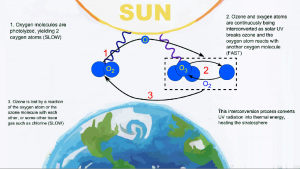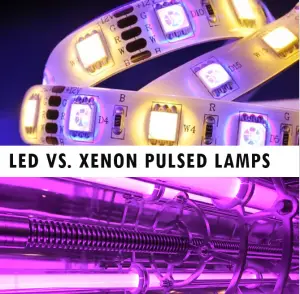In a world full of disinfectant products, it becomes harder and harder to make decisions. There are hundreds of products available on the market. There are chemical disinfectants, and there are physical disinfectants like ultraviolet disinfection units with UVC light.
The key advantages of disinfection with UV light include: more cost effective on the long run, no chemical poisoning or chemical by product, no risk of allergies or sensitivities, wide antimicrobial action and eco-friendly. More details about the difference between chemical and physical disinfectants here in this blog .
Ultraviolet disinfection units come in different forms, shapes and prices. How do you know which device is the right one for you? Let’s see some details.
There are two major types of UVC devices: UVC- LED (LED stands for A light-emitting diode) and Xenon lamps with UVC light which can be further classified into continuous and pulsed Xenon UVC lamps.
Quick Comparison: UVC LED Versus Pulsed Xenon UV Light
LED UVC devices may be the first to catch your eyes, as they are quite inexpensive. They typically cost between $50 to $150. LEDs have monochromatic, narrow, single wavelength and the minimal wavelength is 250 nm. As a result, they have limited antimicrobial effects. In addition, LED devices work only on the surfaces exposed to the light, and therefore unable to kill microbes found in the shaded areas where UVC light can not reach.
Another thing to consider is that LED UVC devices require a lot of radiant energy (fluence), which means they aren’t energy efficient.
Let’s see now what Xenon UVC devices can offer. Instead of having a single wavelength, these devices have a wide spectrum of wavelengths starting at 170 nm. As a result, they have a broader antimicrobial effect, which means they have the ability to kill more effectively a variety of viruses and bacteria. Pulse Xenon lamps are faster and more effective than continuous Xenon lamps as they produce high intensity UV light. This powerful light passes through the walls of bacteria, viruses and fungi, damaging their RNA/DNA and proteins required for multiplication.
Unlike LED devices, pulsed xenon UVC light can kill microbes found in shaded areas.
UV light in the range from 160 – 240 nm naturally creates ozone from oxygen. Ozone (O3) is produced in the stratosphere when solar radiation strikes molecules of oxygen (O2) , and cause the two oxygen atoms to split apart in a process known as photolysis. When a freed atom collides with another molecule of oxygen, it will form ozone (O3) [1]
Source: wikimedia commons
Ozone helps to “carry” the UV radiation in the air to where it normally cannot reach directly,, for example- in shaded areas. Ozone is also a potent antimicrobial compound on its own [2]. In terms of radiant energy, xenon UVC lamps require less fluence, which means they are more energy efficient compared with LED devices.
Key points LED-UVC Vs Xenon -UVC Lamp
| Ultraviolet disinfection unit LED -UVC | Ultraviolet disinfection unit Xenon- UVC |
Antimicrobial action | Limited | Broad spectrum coverage |
Wavelength | (250 nm), monochromatic | Wide spectrum wavelengths starting at 170 nm |
Ozone gas production by light source | No. Ozone is created from UV light with wavelength between emission 160nm-240nm | Yes! Ozone penetrates and sanitizes shaded areas like in mice, keyboards, remote controls, etc. |
Inactivates/kills microbes in shaded areas | No | Yes |
Radiant energy (fluence) required |
High fluence (not energy efficient) |
Lower fluence (it is energy efficient) |
Overall effectiveness | Limited | Very effective |
Cost | $50- $150 | $500-$10,000 |
“You get what you pay for. Any [UVC] device selling for under $150 is probably not effective or reliable. Most quality devices are probably closer to the $300 to $500 range or higher” says Jim Malley, PhD, professor of civil and environmental engineering at the University of New Hampshire, who is testing how well UVC can sanitize devices and protective gear in hospitals during COVID-19 -19 outbreak. One more advice from Dr Malley: “Lack of a user’s manual, lack of customer and technical service departments, and lack of performance data from independent testing labs all suggest it will not be a good purchase”[3].
Safety note: PXL Sanitizer comes with full training manual, and UVC safety glasses. All UVC devices should be used on surfaces only, avoid skin or eye exposure to UVC light.
Ready to try PXL Sanitizer, which is a disinfection UV unit that uses pulsed xenon UV light and had been tested by third party independent lab ? Email us today.
Tzachi Sabati
CEO, IZAK Scientific
Physicist specializing in photonics and quantum technologies, with deep expertise in quantum sensors and advanced optical systems. Leads the Advanced Quantum Lab course at the Technion, bridging academic excellence with industry innovation. At IZAK Scientific, provides cutting-edge photonics-based solutions, developing customized inspection and sensing systems for R&D and production. Passionate about advancing quantum sensing applications and integrating novel technologies to meet industry needs.

